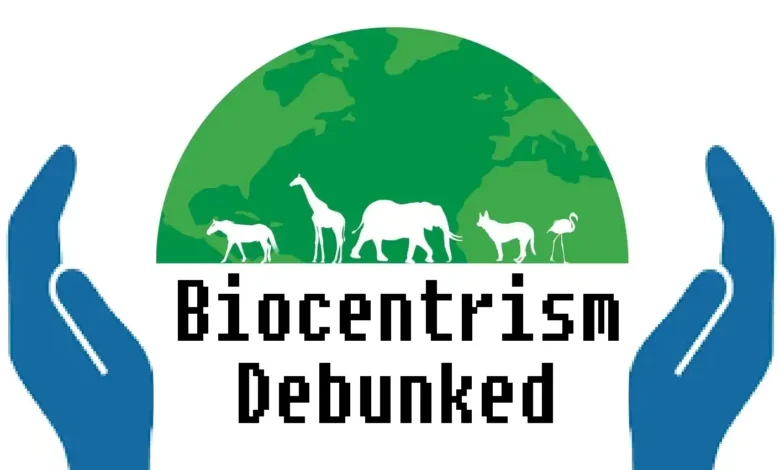
In a world where the environment is increasingly threatened, there is a growing movement that seeks to shift our perspective from human-centered to nature-centered. Biocentrism, the belief that all living organisms have inherent value and rights, is gaining traction as a powerful force in reshaping environmental ethics. Join us as we explore how this concept is revolutionizing our relationship with the natural world and outlining a new path toward sustainable coexistence.
- What is Biocentrism?
- Key Features of Biocentrism
- The History and Evolution of Biocentrism
- Biocentrism Debunkers
- Key Principles and Beliefs of Biocentrism
- How Biocentrism Differs from Other Environmental Ethics
- Real-World Applications of Biocentrism
- Criticisms and Controversies Surrounding Biocentrism
- Future Outlook and Impact of Biocentrism on Environmental Ethics
- Embracing a More Holistic View of Our Relationship with Nature
What is Biocentrism?
Biocentrism is a concept that has gained significant traction in the field of environmental ethics in recent years. It challenges traditional anthropocentric views that prioritize humans over all other living beings and re-evaluates our relationship with the natural world.
At its core, biocentrism posits that all living beings, including humans, have inherent value and deserve moral consideration. This means that non-human entities such as plants, animals, and ecosystems should be treated with respect and consideration for their well-being. This ethical framework stands in stark contrast to anthropocentrism, which views humans as superior and prioritizes human needs above those of other species.
The term “biocentrism” was first coined by philosopher Paul Taylor in his 1986 book “Respect for Nature.” In this work, Taylor argued that all living organisms possess inherent worth simply by virtue of being alive. He believed that this intrinsic value should guide our ethical decisions towards nature.
Key Features of Biocentrism
- One key aspect of biocentrism is the recognition of the interconnectedness between all forms of life on Earth. The impact of human actions on one species or ecosystem can have far-reaching consequences on others. Thus, taking care to preserve biodiversity is crucial not only for individual species but also for the health and balance of entire ecosystems.
- Another key aspect, biocentrists reject the notion that nature exists solely to serve human interests. Instead, they view humans as part of a larger community of living beings with equal rights to exist and thrive on this planet.
- This concept also extends beyond just living beings; it includes recognizing the intrinsic value and rights of non-living components like rivers, mountains, and forests. These elements are vital parts of an ecosystem’s functioning and must be considered when making decisions about their use or preservation.
- Another important aspect of biocentrism is its emphasis on sustainability. Biocentric ethics require us to consider not only the short-term benefits of our actions but also the long-term consequences for future generations. This perspective encourages responsible and sustainable resource management practices that ensure the well-being of all living beings, not just humans.
Biocentrism presents a paradigm shift in environmental ethics, challenging us to reconsider our relationship with nature and recognize the inherent value of all living beings. This concept has paved the way for more holistic and sustainable approaches towards protecting our planet’s biodiversity and preserving its delicate balance.
The History and Evolution of Biocentrism
The concept of biocentrism, or the belief that all living beings have inherent value and should be treated with respect and consideration, has been around for centuries. It can be traced back to ancient philosophical traditions such as Buddhism, which viewed all living things as interconnected and deserving of ethical consideration.
However, it wasn’t until the 20th century that biocentrism gained more traction and attention in Western societies. In the early 1970s, a series of environmental crises brought attention to the impact of human activities on the natural world. This led to a growing concern for the well-being of non-human species and ecosystems, and sparked discussions about how humans should interact with nature.
Biocentrism Debunkers
Fast forward to today, biocentrism has become an increasingly important concept in environmental ethics and activism. As humans continue to face the consequences of our unsustainable practices such as climate change and biodiversity loss, the need for a more holistic and ethical approach towards nature becomes even more pressing.
- One key figure in the development of biocentrism was Aldo Leopold, an American ecologist and conservationist who is often referred to as “the father of wildlife management”. In his influential book “A Sand County Almanac” published in 1949, Leopold argued for a shift from anthropocentrism (the belief that humans are at the center of existence) to biocentrism. He emphasized the importance of understanding and respecting nature’s processes and cycles rather than viewing it solely as a resource for human use.
- Another important milestone in the history of biocentrism was the publication of Australian philosopher Peter Singer’s book “Animal Liberation” in 1975. Singer argued that animals have their own intrinsic value and deserve moral consideration regardless of their usefulness to humans. This idea challenged traditional views on animal welfare which focused mainly on preventing unnecessary suffering rather than acknowledging animals’ inherent worth.
In addition to these notable figures, indigenous cultures around the world have long-held beliefs aligned with biocentrism. Many Indigenous communities view themselves as part of nature rather than separate from it, recognizing that every living being has its own unique role in maintaining balance within ecosystems.
The evolution of biocentrism reflects a growing understanding that all living beings are interconnected and interdependent and that our well-being is intimately tied to the health of the natural world. It highlights the importance of acknowledging and respecting the intrinsic value of all forms of life, and serves as a guiding principle for creating a more sustainable future for both humans and non-human beings alike.
Key Principles and Beliefs of Biocentrism
The concept of biocentrism is a relatively new philosophy that has been gaining traction in the field of environmental ethics. It puts forward the idea that all living beings, not just humans, have intrinsic value and deserve moral consideration. This means that all organisms have a right to exist and flourish on their own terms, rather than simply being seen as resources for human use.
At its core, biocentrism is based on two key principles: the interconnectedness of all life and the inherent value of every living being. These principles go hand in hand and form the foundation of this ethical framework.
The First Principle
The first principle, interconnectedness, recognizes that all living beings are connected and dependent on each other for survival. This means that any action or decision made by one organism can have a ripple effect on others within an ecosystem. Biocentric thinkers believe that this interconnectedness should be respected and considered when making choices related to the environment.
The Second Principle
The second principle, inherent value, asserts that all living beings possess inherent worth regardless of their usefulness to humans. This challenges the traditional anthropocentric view where only humans are deemed valuable and therefore hold dominion over nature. In contrast, biocentrism acknowledges the intrinsic worth of every organism and advocates for protecting them based on their own right to exist.
These two principles are further supported by several beliefs held by biocentric thinkers:
Respect for Biodiversity
Biocentrism recognizes the importance of maintaining a diverse range of species in ecosystems. Each species plays a unique role in maintaining balance and diversity is essential for resilience against environmental changes.
Non-Violence Towards Animals
Biocentrists reject violence towards animals, including hunting for sport or using them for entertainment purposes. They believe in treating animals with compassion and respect as they too have interests in their lives.
Sustainable Use of Resources
While acknowledging the need for humans to use natural resources for survival, biocentrism emphasizes the importance of sustainable practices. This means using resources in a way that does not deplete them for future generations.
Rights of Future Generations
Biocentrists recognize the rights of future generations to inherit a healthy and diverse environment. They believe it is our moral obligation to preserve natural resources and biodiversity for the well-being of future inhabitants.
Biocentrism challenges traditional human-centered beliefs and calls for a more inclusive perspective toward our relationship with nature. It encourages us to shift our focus from solely meeting human needs to considering the needs of all living beings on Earth. By incorporating these principles and beliefs into our environmental ethics, we can work towards creating a more sustainable and equitable world for all species.
How Biocentrism Differs from Other Environmental Ethics
Biocentrism is a relatively new concept in the field of environmental ethics that puts emphasis on valuing and respecting all living beings, rather than just focusing on human interests. This approach stands in contrast to other types of environmental ethics, such as anthropocentrism or ecocentrism, which prioritize human needs and well-being above all else. In this section, we will explore how biocentrism differs from these other ethical perspectives.
Anthropocentrism
Anthropocentrism is perhaps the most dominant ethical framework when it comes to our relationship with the natural world. It views humans as the most important and central beings on Earth, giving them sole moral consideration and value. In contrast, biocentrism recognizes that all living creatures have inherent value and deserve moral consideration regardless of their usefulness to humans. This means that biocentric ethics reject the idea that humans have a right to exploit or dominate nature for their own benefit.
Another significant difference between biocentrism and other environmental ethics lies in its rejection of hierarchies among species. Anthropocentric perspectives often place humans at the top of a hierarchy, followed by certain “superior” animals like primates or dolphins. This hierarchical thinking can lead to the exploitation and mistreatment of “lesser” creatures such as insects or plants. However, biocentric principles dictate that every living being holds equal inherent worth and should be treated with equal respect.
Ecocentrism
Ecocentrism places importance on preserving ecosystems as a whole rather than individual species or organisms. While this approach acknowledges the value of non-human life forms, it focuses primarily on maintaining balance within ecosystems for their own sake. Biocentrism differs from ecocentrism by recognizing that each individual organism has its own intrinsic worth and should be respected accordingly.
Biocentric ethics also differ from utilitarian approaches which focus on maximizing overall happiness or pleasure for society as a whole. Instead of prioritizing human interests or the greatest good for the greatest number, biocentrism emphasizes the protection and preservation of all living beings as an end in itself. This is known as intrinsic value, where something has value simply because it exists, rather than for any instrumental or utilitarian purpose.
Biocentrism stands out from other environmental ethics by placing equal moral consideration on all living entities and rejecting hierarchies among species. It recognizes that humans are a part of the natural world and that our well-being is deeply interconnected with the health and flourishing of all other organisms on Earth. By adopting a biocentric perspective, we can shift towards a more holistic and sustainable approach to our relationship with nature.
Real-World Applications of Biocentrism
Biocentrism is a concept that has gained momentum in recent years, particularly within the field of environmental ethics. At its core, biocentrism asserts that all living beings have inherent value and are deserving of moral consideration. This stands in contrast to anthropocentrism, which places humans at the center of ethical consideration and often prioritizes human interests above those of other species.
The rise of biocentrism has led to a shift in how we view and interact with the natural world. This concept has important real-world applications that can help guide our actions towards more sustainable and ethical practices.
One major area where biocentrism is making an impact is in conservation efforts. By recognizing the intrinsic value of all living beings, biocentric principles call for a holistic approach to conservation that takes into account not just individual species but entire ecosystems. This means protecting biodiversity and preserving habitats for all creatures, not just those deemed economically or aesthetically valuable by humans.
Biocentrism is not just a philosophical concept but has tangible real-world applications that are reshaping our relationship with the natural world. By recognizing the inherent value of all living beings, we can work towards a more ethical and sustainable future for ourselves and other species.
Criticisms and Controversies Surrounding Biocentrism
Biocentrism, as a concept, has faced its fair share of criticisms and controversies since it was first introduced in the realm of environmental ethics. At its core, biocentrism challenges the traditional anthropocentric view that places human beings at the center of moral consideration and instead argues for an equal moral status for all living beings.
- One of the main criticisms directed towards biocentrism is that it undermines the importance of human life and prioritizes the well-being of non-human entities. This viewpoint is often fueled by concerns about how biocentrism would impact human societies and economies. Critics argue that shifting to a biocentric perspective would hinder progress and development, as it would require significant changes in our current way of life. They also question whether it is practical or even possible to treat all living beings equally.
- Furthermore, some critics argue that biocentrism oversimplifies complex ethical issues surrounding environmental protection. They believe that giving equal moral consideration to all living beings disregards the fact that different species have different levels of cognitive abilities and therefore cannot be treated on an equal footing. For example, proponents of utilitarian ethics argue that we should prioritize protecting species whose extinction could have a more significant impact on ecosystems rather than treating all species equally.
- Another controversy surrounding biocentrism is its potential conflict with indigenous cultures’ beliefs and practices. Many indigenous communities have a deep connection with nature and see themselves as part of an interconnected web with other living beings. Their relationship with nature is often based on reciprocity rather than equality, which goes against the principles of biocentrism.
- Some critics claim that adopting a strict biocentric approach may not be feasible in certain situations where there are competing interests between humans and other species. For instance, when it comes down to survival needs such as food or shelter, most people would prioritize their own well-being over other living entities.
Despite these criticisms and controversies, biocentrism continues to gain traction in the field of environmental ethics. Proponents argue that the current anthropocentric view has led to severe environmental degradation and that a shift towards biocentrism is necessary for long-term sustainability. They also highlight the importance of recognizing our interconnectedness with nature and understanding that our well-being is inherently tied to the health of the environment.
While there are certainly valid criticisms and controversies surrounding biocentrism, it remains an influential concept that challenges traditional perspectives on environmental ethics. As it continues to shape our understanding of our relationship with nature, ongoing discussions and debates surrounding its implementation will be crucial in determining its role in shaping future sustainability efforts.
Future Outlook and Impact of Biocentrism on Environmental Ethics
The concept of biocentrism has gained significant traction in recent years, with more and more individuals and organizations adopting it as a framework for understanding our relationship with the environment. As we look towards the future, it is clear that biocentrism will continue to shape environmental ethics and have a profound impact on how we interact with nature.
One of the key ways in which biocentrism is expected to influence environmental ethics is by shifting our focus from human-centric to nature-centric perspectives. Biocentric ethics places equal value on all living beings, rather than prioritizing the needs and desires of humans above all else. This shift towards valuing non-human entities as inherently valuable and deserving of moral consideration has the potential to greatly improve our treatment of the natural world.
Another significant impact that biocentrism is likely to have on environmental ethics is its potential for creating a more inclusive approach to conservation efforts. Traditional conservation methods often prioritize certain iconic or economically important species over others. However, biocentric ethics recognizes the inherent value of all living beings regardless of their perceived importance or usefulness to humans. This could lead to a more holistic approach towards conservation that considers not just individual species but also their roles within larger ecosystems.
As we continue to face pressing environmental issues such as climate change, pollution, deforestation, and mass extinction rates, it has become increasingly clear that traditional anthropocentric approaches are no longer sufficient in addressing these challenges. Biocentrism offers a more comprehensive and compassionate approach to environmental ethics, which could be crucial in finding sustainable solutions for these complex issues.
The rise of biocentrism is set to have a significant impact on environmental ethics in the future. By shifting our focus towards nature-centric perspectives, influencing policy-making processes, promoting inclusivity in conservation efforts, and providing a more holistic approach to addressing environmental challenges, biocentrism has the potential to reshape our relationship with the natural world for the better.
Embracing a More Holistic View of Our Relationship with Nature
In recent years, the concept of biocentrism has gained traction in shaping environmental ethics and our understanding of our relationship with nature. Traditional environmental philosophies have often placed humans at the center, viewing nature as a resource to be exploited for human benefit. However, biocentrism challenges this anthropocentric view and urges us to embrace a more holistic perspective that considers all living beings as deserving of moral consideration.
Through embracing biocentrism, we can begin to shift towards a more sustainable and ethical approach to interacting with nature. Instead of seeing ourselves as separate from or above the natural world, biocentrism emphasizes our interconnectedness with all other living beings. This recognition can lead to a deeper appreciation and respect for the environment and its inhabitants.
We hope you found this article helpful. If you did, be sure to check out our blog for more great content like this.





